Static and Dynamic Accuracy and Occlusion Robustness of SteamVR Tracking 2.0 in Multi-Base Station Setups
Abstract
1. Introduction
2. Related Work
- Dynamic analysis: A setting with dynamic positions of the tracked object during measurements, e.g., for baseline accuracy determination.
- Dynamic precision analysis: A setting with a dynamic analysis during repeated measurement runs, e.g., for repeatability determination.
- Loss of tracking: A state with the tracking system losing the connection to the tracked object.
- Orientational accuracy: A characteristic describing the deviation of the measured positions to the real positions at the rotational movement.
- Partial occlusion: A state where scan information is partially lost due to occlusion of at least one camera/scanner (depending on the tracking system).
- Positional accuracy: A characteristic describing the deviation of the measured positions to the real positions at the translational movement.
- Reliability analysis: A setting with static or dynamic positions of at least two trackers, e.g., for intra- and inter-tracker accuracy determination.
- Static analysis: A setting with static positions of the tracked object during measurements, e.g., for baseline accuracy determination.
- Static precision analysis: A setting with a static analysis during repeated measurement runs, e.g., for repeatability determination.
- System latency: A characteristic indicating the time between physical movement of the tracked object and this movement being reflected on the screen.
- Time performance analysis: A setting with static or dynamic positions of the tracked object during measurements, e.g., for system latency determination.
- Total occlusion: A state where scan information is completely lost for a certain time due to occlusion of the tracked object.
| Ref. | Year | Vers. | Base Stations | GTS | Analysis Type | Runs | Drifts |
|---|---|---|---|---|---|---|---|
| [4] | 2019 | 1.0 | 2 | Universal Robots UR5 | SA: PA, OA | 5 each | Yes |
| [21] | 2017 | 1.0 | 2 | 2D grid | (1) SA: PA, OA with LOT (2) SA: PA, OA without LOT (3) SA: PA, OA with simulated LOT (4) TPA: SL | (1) 1 each (2) 1 each (3) 20, 10, and 20 (4) 6 | No |
| [23] | 2021 | 1.0 | 2 | Comau NS-16-1.65 | (1) SPA: PA, OA (2) SA: PA, OA (3) DA: PA, OA | (1) 10 each (2) 1 each (3) 1 each | No |
| [24] | 2018 | 1.0 | 2 | PhaseSpace | (1) SA: PA (2) SA: PA with PO (3) SA: PA without occlusion (4) SA: PA | (1) 5 (2) 20 (3) 1 (4) 2 | Yes |
| [25] | 2019 | 1.0 | 2 | SCORBOT ER VII | SA: PA, OA | 4 each | No |
| [29] | 2019 | 1.0 | 2 | Universal Robots UR5 | DA: PA, OA | 30 each | No |
| [26] | 2018 | 1.0 | 2 | Astrobee | (1) SA: PA, OA (2) DA: PA, OA | (1) 5 each (2) 4 and 3 | No |
| [27] | 2020 | 1.0 | 2 | UKA LBR iiwa 14 R820 | (1) DPA: PA, OA (2) DA: PA, OA | (1) 5 each (2) 1 each | No |
| [28] | 2022 | 1.0 | 2 | 2D grid | (1) RA: intra- and intertracker accuracy (2) SA: PA with TO and PO | (1) 4 each (2) 4 each | Yes |
| [30] | 2021 | 2.0 | 1, 2 | Stable surveying pillars | (1) SPA: PA (2) SA: PA, OA | (1) 1 (2) 1 each | No |
| [31] | 2021 | 2.0 | 4 | 2D grid | (1) RA: intertracker accuracy (2) SA: PA (3) SPA: jitter | (1) 1 (2) 1 (3) 1 | No |
| This work | 2.0 | 2, 4 | Universal Robots UR10 | (1) SA: PA, OA (2) DA: PA (3) SA: PA with PO | (1) 5 each (2) 5 (3) 5 | No |
3. Materials and Methods
3.1. SteamVR Tracking Hardware and Software
3.2. Universal Robots UR10 Robot Arm
3.3. Experimental Environment and Setups
3.4. Evaluation Procedures
3.5. Evaluation Metric
4. Results
4.1. Static Translation and Rotation Accuracy
4.2. Dynamic Translation Accuracy
4.3. Static Translation Robustness
5. Discussion
5.1. Static Tracking Accuracy
5.2. Dynamic Tracking Accuracy
5.3. Occlusion Robustness
5.4. Limitations
6. Conclusions
Author Contributions
Funding
Institutional Review Board Statement
Informed Consent Statement
Data Availability Statement
Acknowledgments
Conflicts of Interest
Abbreviations
| API | Application Programming Interface |
| GTS | Ground Truth System |
| IR | Infrared |
| RMSE | Root Mean Square Error |
| TCP | Tool Center Point |
| USB | Universal Serial Bus |
| VR | Virtual Reality |
References
- Mystakidis, S. Metaverse. Encyclopedia 2022, 2, 486–497. [Google Scholar] [CrossRef]
- Dębska, M.; Polechoński, J.; Mynarski, A.; Polechoński, P. Enjoyment and Intensity of Physical Activity in Immersive Virtual Reality Performed on Innovative Training Devices in Compliance with Recommendations for Health. Int. J. Environ. Res. Public Health 2019, 16, 3673. [Google Scholar] [CrossRef] [PubMed]
- Mäkinen, H.; Haavisto, E.; Havola, S.; Koivisto, J.M. User experiences of virtual reality technologies for healthcare in learning: An integrative review. Behav. Inf. Technol. 2020, 41, 1–17. [Google Scholar] [CrossRef]
- Ameler, T.; Blohme, K.; Brandt, L.; Brüngel, R.; Hensel, A.; Huber, L.; Kuper, F.; Swoboda, J.; Warnecke, M.; Warzecha, M.; et al. A Comparative Evaluation of SteamVR Tracking and the OptiTrack System for Medical Device Tracking. In Proceedings of the 2019 41st Annual International Conference of the IEEE Engineering in Medicine and Biology Society (EMBC), Berlin, Germany, 23–27 July 2019; pp. 1465–1470. [Google Scholar] [CrossRef]
- Konge, L.; Albrecht-Beste, E.; Nielsen, M. Virtual-reality Simulation-based Training in Ultrasound. Ultraschall Med.-Eur. J. Ultrasound 2014, 35, 95–97. [Google Scholar] [CrossRef] [PubMed]
- Byl, B.; Suncksen, M.; Teistler, M. A serious virtual reality game to train spatial cognition for medical ultrasound imaging. In Proceedings of the 2018 IEEE 6th International Conference on Serious Games and Applications for Health (SeGAH), Vienna, Austria, 16–18 May 2018; pp. 1–4. [Google Scholar] [CrossRef]
- Blum, T.; Heining, S.M.; Kutter, O.; Navab, N. Advanced training methods using an Augmented Reality ultrasound simulator. In Proceedings of the 2009 8th IEEE International Symposium on Mixed and Augmented Reality, Orlando, FL, USA, 19–22 October 2009; pp. 1652–1656. [Google Scholar] [CrossRef]
- Kutarnia, J.F.; Pedersen, P.C.; Yuan, C. Virtual reality training system for diagnostic ultrasound. In Proceedings of the 2010 IEEE International Ultrasonics Symposium, San Diego, CA, USA, 11–14 October 2010; pp. 1652–1656. [Google Scholar] [CrossRef]
- Burden, C.; Preshaw, J.; White, P.; Draycott, T.J.; Grant, S.; Fox, R. Usability of virtual-reality simulation training in obstetric ultrasonography: A prospective cohort study. Ultrasound Obstet. Gynecol. 2013, 42, 213–217. [Google Scholar] [CrossRef] [PubMed]
- Samadbeik, M.; Yaaghobi, D.; Bastani, P.; Abhari, S.; Rezaee, R.; Garavand, A. The Applications of Virtual Reality Technology in Medical Groups Teaching. J. Adv. Med. Educ. Prof. 2018, 6, 123–129. [Google Scholar]
- Hsieh, M.C.; Lee, J.J. Preliminary Study of VR and AR Applications in Medical and Healthcare Education. J. Nurs. Health Stud. 2018, 3, 1. [Google Scholar] [CrossRef]
- Remtulla, R. The Present and Future Applications of Technology in Adapting Medical Education Amidst the COVID-19 Pandemic. JMIR Med. Educ. 2020, 6, e20190. [Google Scholar] [CrossRef]
- Fiani, B.; Stefano, F.D.; Kondilis, A.; Covarrubias, C.; Reier, L.; Sarhadi, K. Virtual Reality in Neurosurgery: “Can You See It?”—A Review of the Current Applications and Future Potential. World Neurosurg. 2020, 141, 291–298. [Google Scholar] [CrossRef] [PubMed]
- Singh, R.P.; Javaid, M.; Kataria, R.; Tyagi, M.; Haleem, A.; Suman, R. Significant applications of virtual reality for COVID-19 pandemic. Diabetes Metab. Syndr. Clin. Res. Rev. 2020, 14, 661–664. [Google Scholar] [CrossRef]
- Silva, J.N.; Southworth, M.; Raptis, C.; Silva, J. Emerging Applications of Virtual Reality in Cardiovascular Medicine. JACC Basic Transl. Sci. 2018, 3, 420–430. [Google Scholar] [CrossRef] [PubMed]
- Javaid, M.; Haleem, A. Virtual reality applications toward medical field. Clin. Epidemiol. Glob. Health 2020, 8, 600–605. [Google Scholar] [CrossRef]
- Stanica, I.C.; Moldoveanu, F.; Portelli, G.P.; Dascalu, M.I.; Moldoveanu, A.; Ristea, M.G. Flexible Virtual Reality System for Neurorehabilitation and Quality of Life Improvement. Sensors 2020, 20, 6045. [Google Scholar] [CrossRef] [PubMed]
- Baran, M.; Lehrer, N.; Siwiak, D.; Chen, Y.; Duff, M.; Ingalls, T.; Rikakis, T. Design of a home-based adaptive mixed reality rehabilitation system for stroke survivors. In Proceedings of the 2011 Annual International Conference of the IEEE Engineering in Medicine and Biology Society, Boston, MA, USA, 30 August–3 September 2011; pp. 7602–7605. [Google Scholar] [CrossRef]
- Pereira, M.F.; Prahm, C.; Kolbenschlag, J.; Oliveira, E.; Rodrigues, N.F. A Virtual Reality Serious Game for Hand Rehabilitation Therapy. In Proceedings of the 2020 IEEE 8th International Conference on Serious Games and Applications for Health (SeGAH), Vancouver, BC, Canada, 12–14 August 2020; pp. 1–7. [Google Scholar] [CrossRef]
- Luckett, E.; Key, T.; Newsome, N.; Jones, J.A. Metrics for the Evaluation of Tracking Systems for Virtual Environments. In Proceedings of the 2019 IEEE Conference on Virtual Reality and 3D User Interfaces (VR), Osaka, Japan, 23–27 March 2019; pp. 1711–1716. [Google Scholar] [CrossRef]
- Niehorster, D.C.; Li, L.; Lappe, M. The Accuracy and Precision of Position and Orientation Tracking in the HTC Vive Virtual Reality System for Scientific Research. i-Perception 2017, 8, 204166951770820. [Google Scholar] [CrossRef] [PubMed]
- Universal Robots A/S. Universal Robots User Manual: UR10/CB3 Original Instruction (en); Technical Report 9.5.92; Universal Robots A/S: Odense, Denmark, 2021; Available online: https://www.universal-robots.com/download/manuals-cb-series/user/ur10/315/user-manual-incl-euromap-67-ur10-cb-series-sw315-english-international-en/ (accessed on 20 December 2022).
- Ikbal, M.S.; Ramadoss, V.; Zoppi, M. Dynamic Pose Tracking Performance Evaluation of HTC Vive Virtual Reality System. IEEE Access 2021, 9, 3798–3815. [Google Scholar] [CrossRef]
- Luckett, E. A Quantitative Evaluation of the HTC Vive for Virtual Reality Research. Ph.D. Thesis, University of Mississippi, University, MS, USA, 2018. [Google Scholar]
- van der Veen, S.; Bordeleau, M.; Pidcoe, P.; France, C.; Thomas, J. Agreement Analysis between Vive and Vicon Systems to Monitor Lumbar Postural Changes. Sensors 2019, 19, 3632. [Google Scholar] [CrossRef] [PubMed]
- Borges, M.; Symington, A.; Coltin, B.; Smith, T.; Ventura, R. HTC Vive: Analysis and Accuracy Improvement. In Proceedings of the 2018 IEEE/RSJ International Conference on Intelligent Robots and Systems (IROS), Madrid, Spain, 1–5 October 2018; pp. 2610–2615. [Google Scholar] [CrossRef]
- Sitole, S.P.; LaPre, A.K.; Sup, F.C. Application and Evaluation of Lighthouse Technology for Precision Motion Capture. IEEE Sens. J. 2020, 20, 8576–8585. [Google Scholar] [CrossRef]
- Sansone, L.G.; Stanzani, R.; Job, M.; Battista, S.; Signori, A.; Testa, M. Robustness and static-positional accuracy of the SteamVR 1.0 virtual reality tracking system. Virtual Real. 2022, 26, 903–924. [Google Scholar] [CrossRef]
- Jost, T.A.; Drewelow, G.; Koziol, S.; Rylander, J. A quantitative method for evaluation of 6 degree of freedom virtual reality systems. J. Biomech. 2019, 97, 109379. [Google Scholar] [CrossRef] [PubMed]
- Bauer, P.; Lienhart, W.; Jost, S. Accuracy Investigation of the Pose Determination of a VR System. Sensors 2021, 21, 1622. [Google Scholar] [CrossRef] [PubMed]
- Holzwarth, V.; Gisler, J.; Hirt, C.; Kunz, A. Comparing the Accuracy and Precision of SteamVR Tracking 2.0 and Oculus Quest 2 in a Room Scale Setup. In Proceedings of the 2021 the 5th International Conference on Virtual and Augmented Reality Simulations, Melbourne, VIC, Australia, 20–22 March 2021; pp. 42–46. [Google Scholar] [CrossRef]
- HTC Corporation. VIVE Tracker (3.0): Developer Guidelines; Technical Report 1.1; HTC Corporation: Taoyuan, Taiwan, 2021; Available online: https://developer.vive.com/resources/hardware-guides/vive-tracker-developer-guidelines/?site=eu& (accessed on 20 December 2022).
- ISO 1222:2010; Photography—Tripod Connections. International Organization for Standardization: Geneva, Switzerland, 2010. Available online: https://www.iso.org/standard/55918.html (accessed on 20 December 2022).
- ISO 9283:1998; Manipulating Industrial Robots—Performance Criteria and Related Test Methods. International Organization for Standardization: Geneva, Switzerland, 1998. Available online: https://www.iso.org/standard/22244.html (accessed on 20 December 2022).
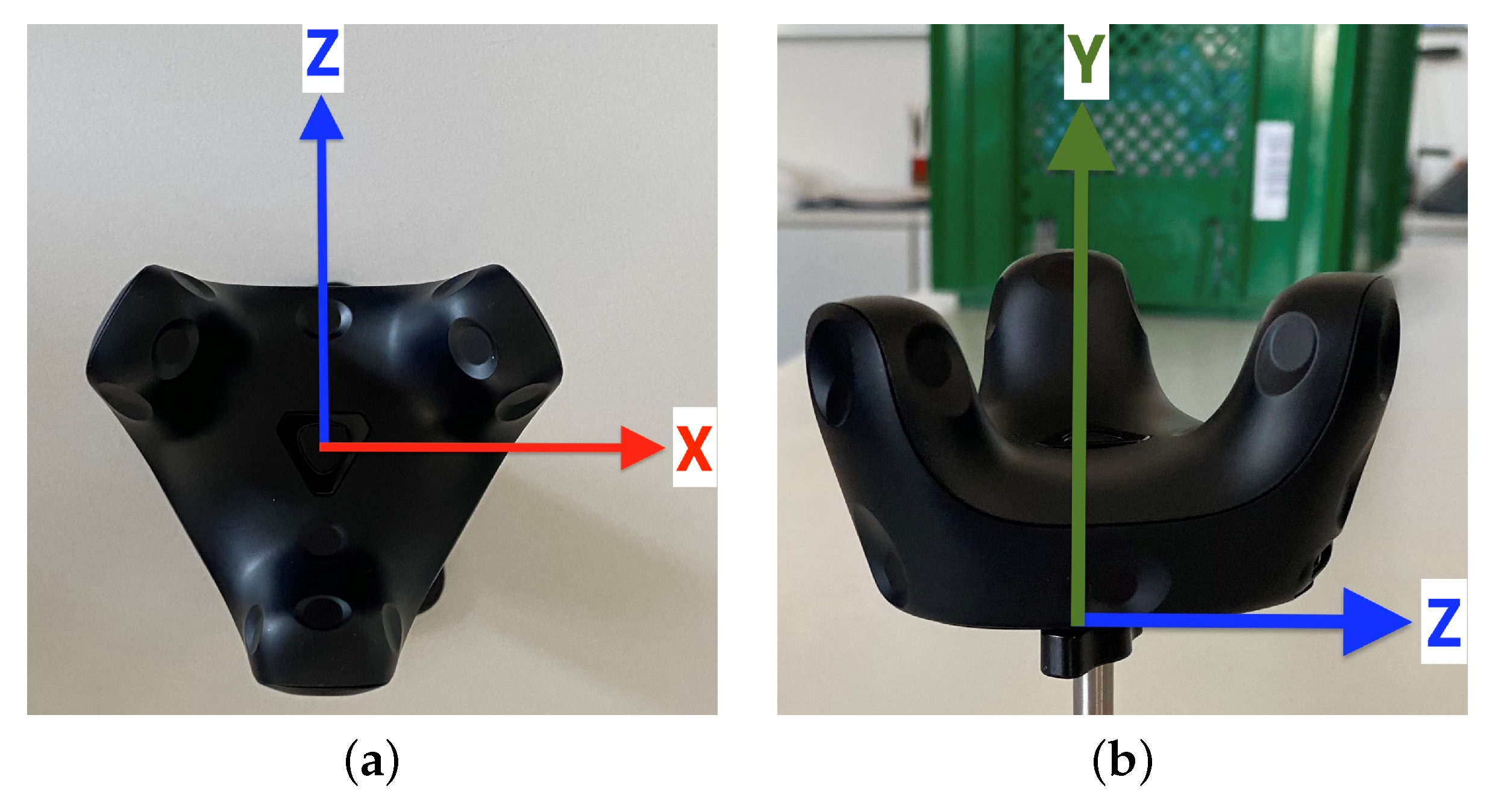
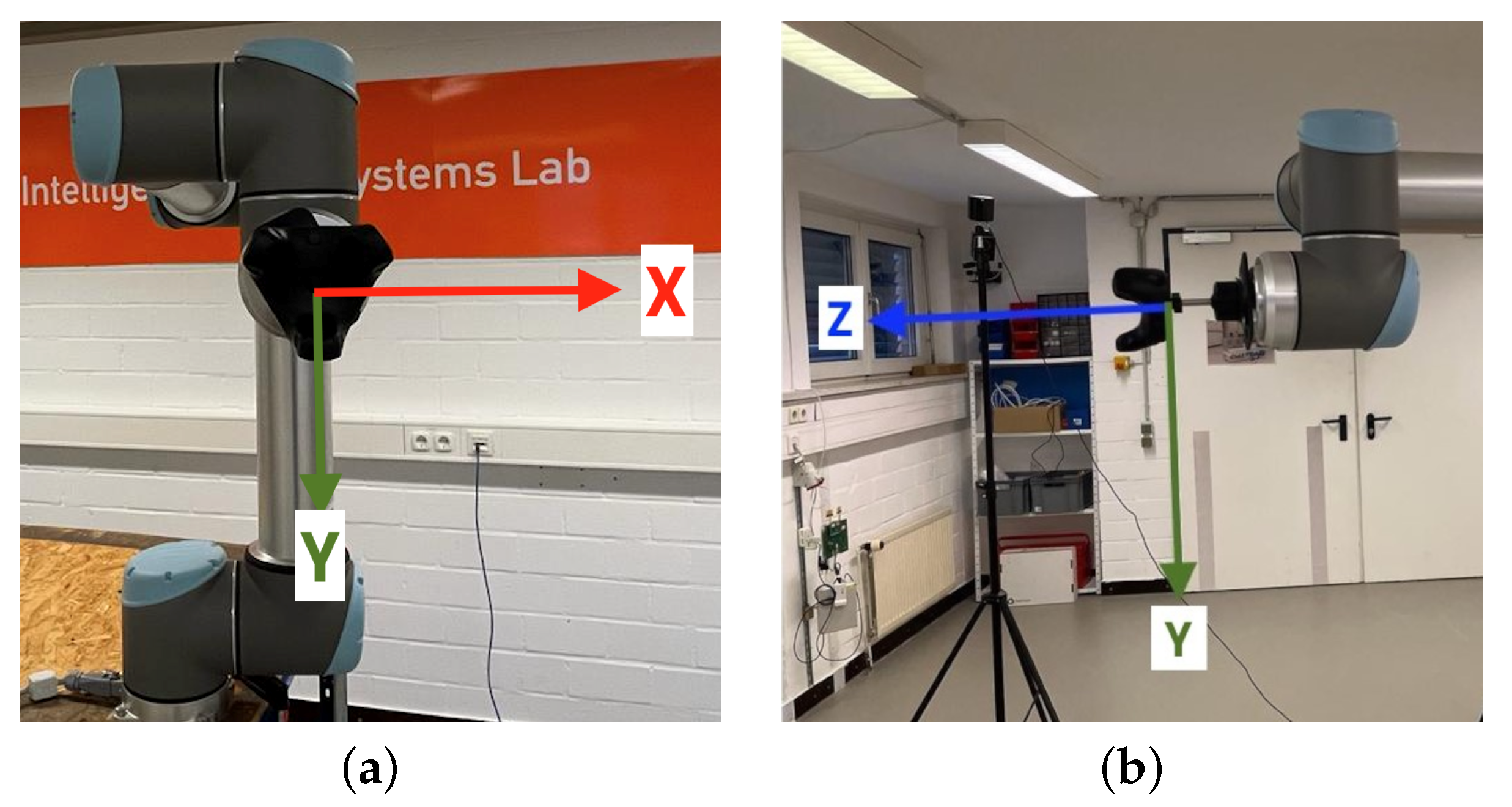
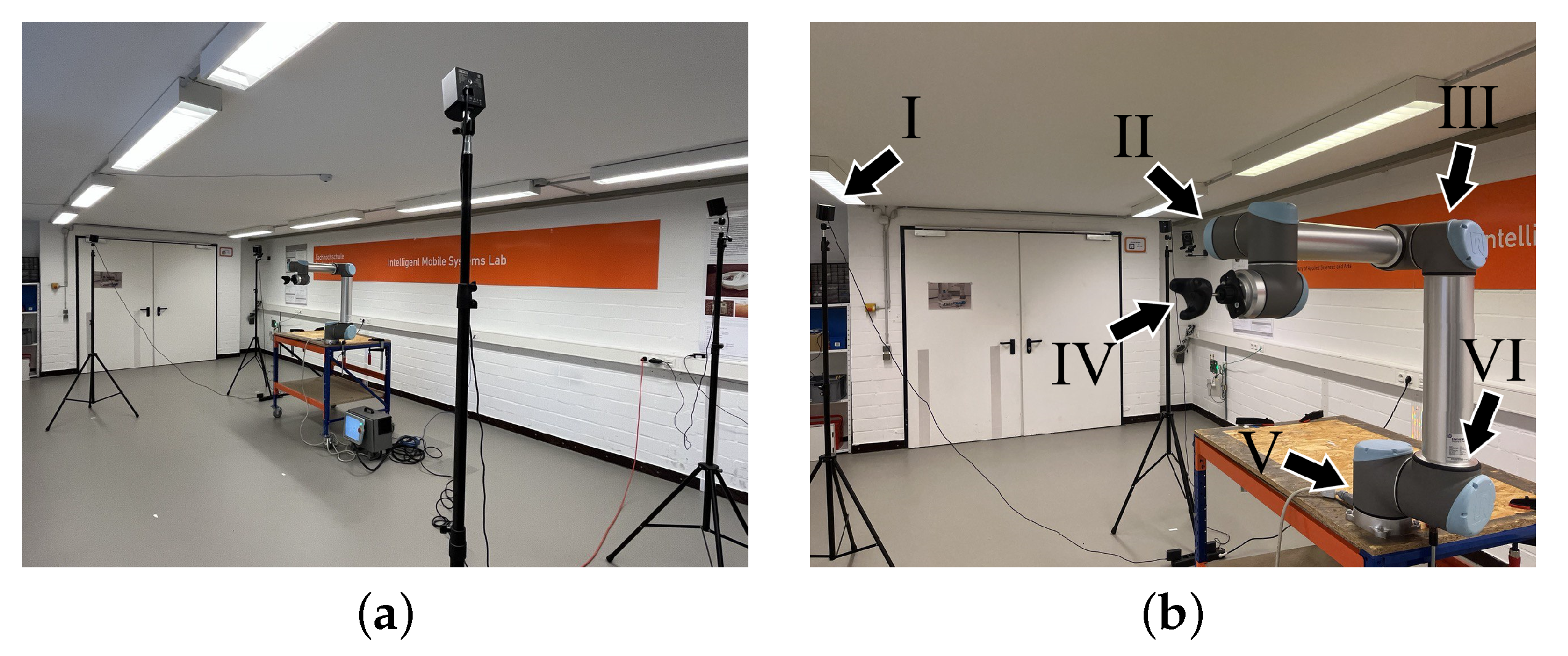
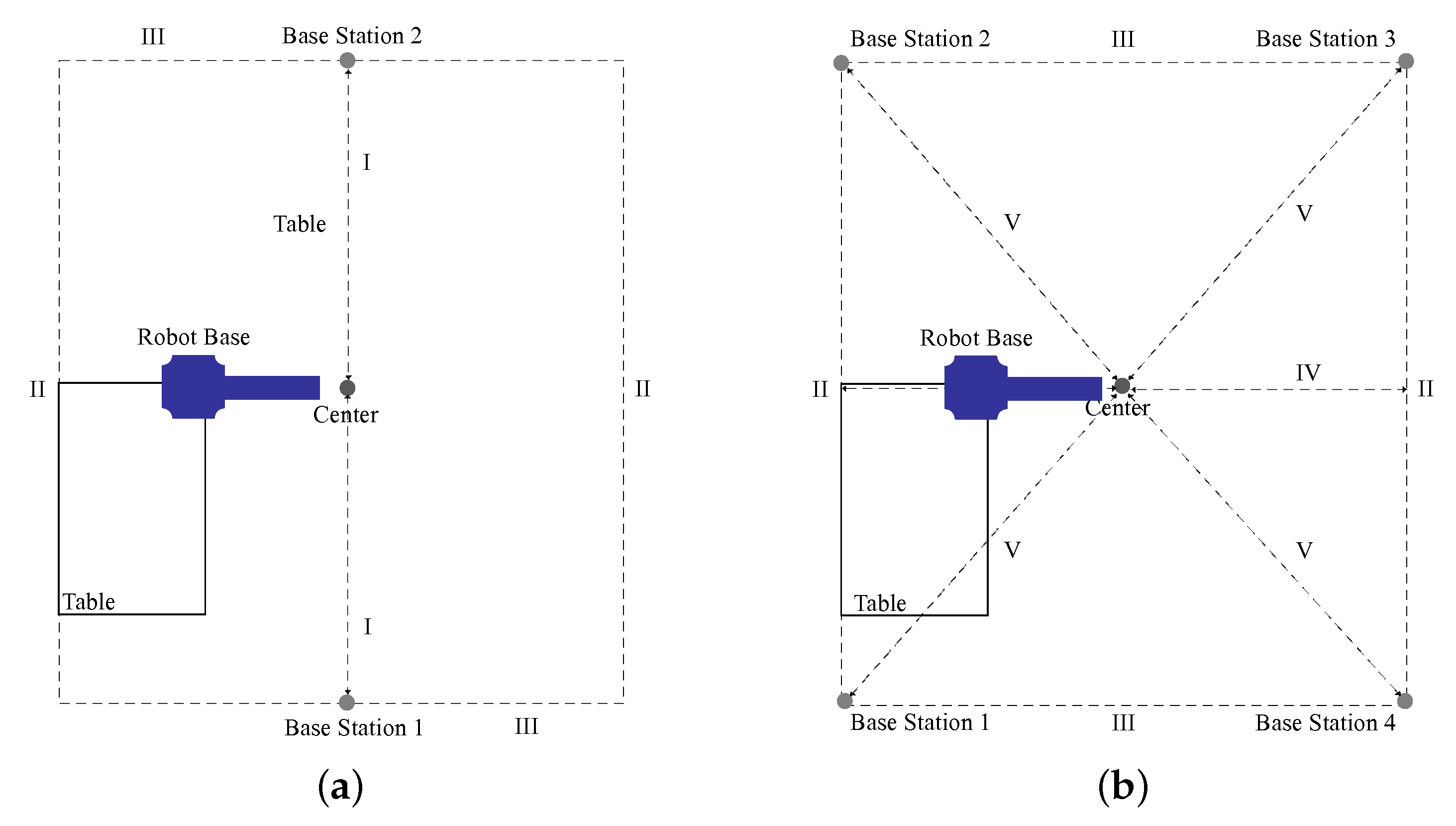
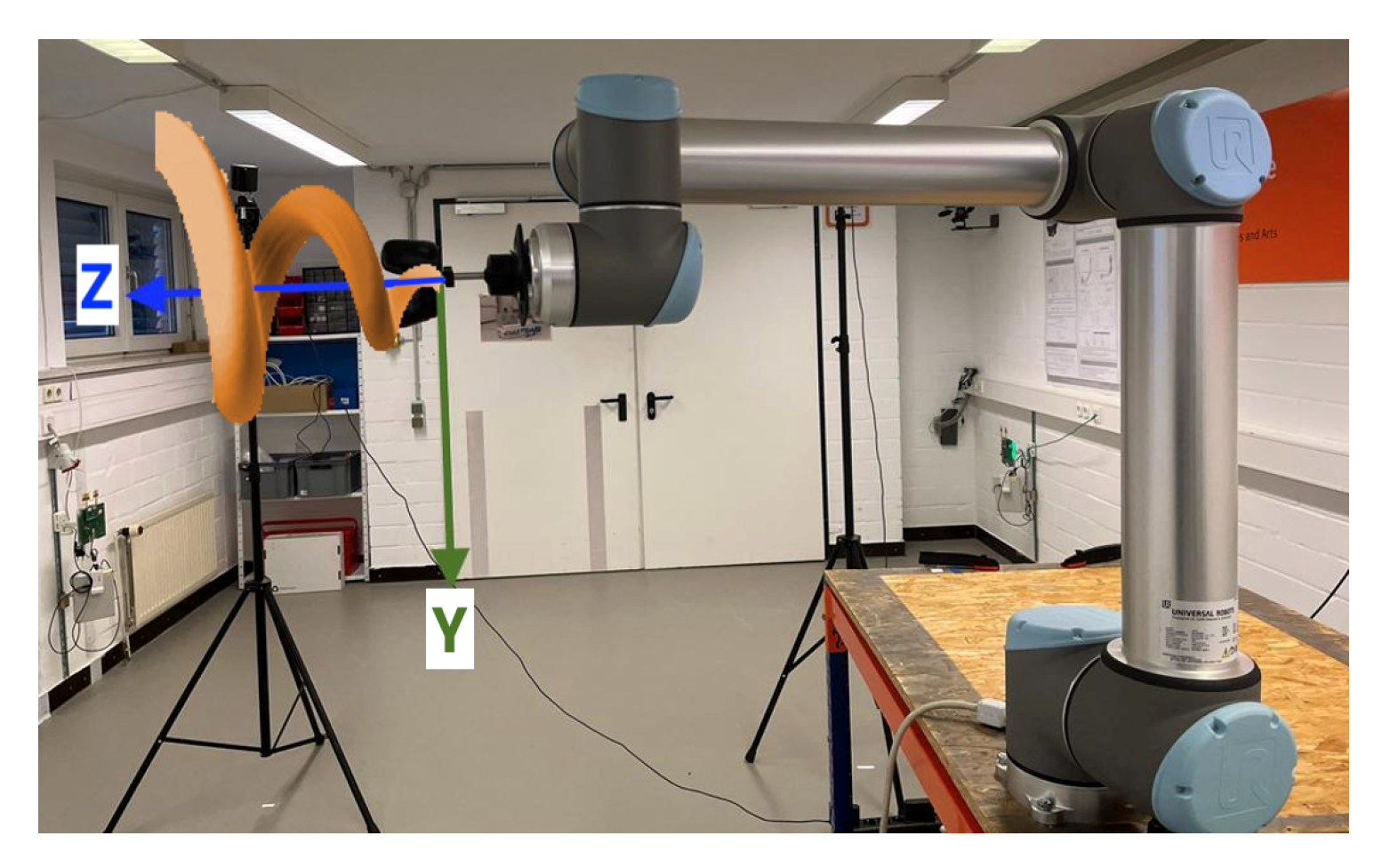
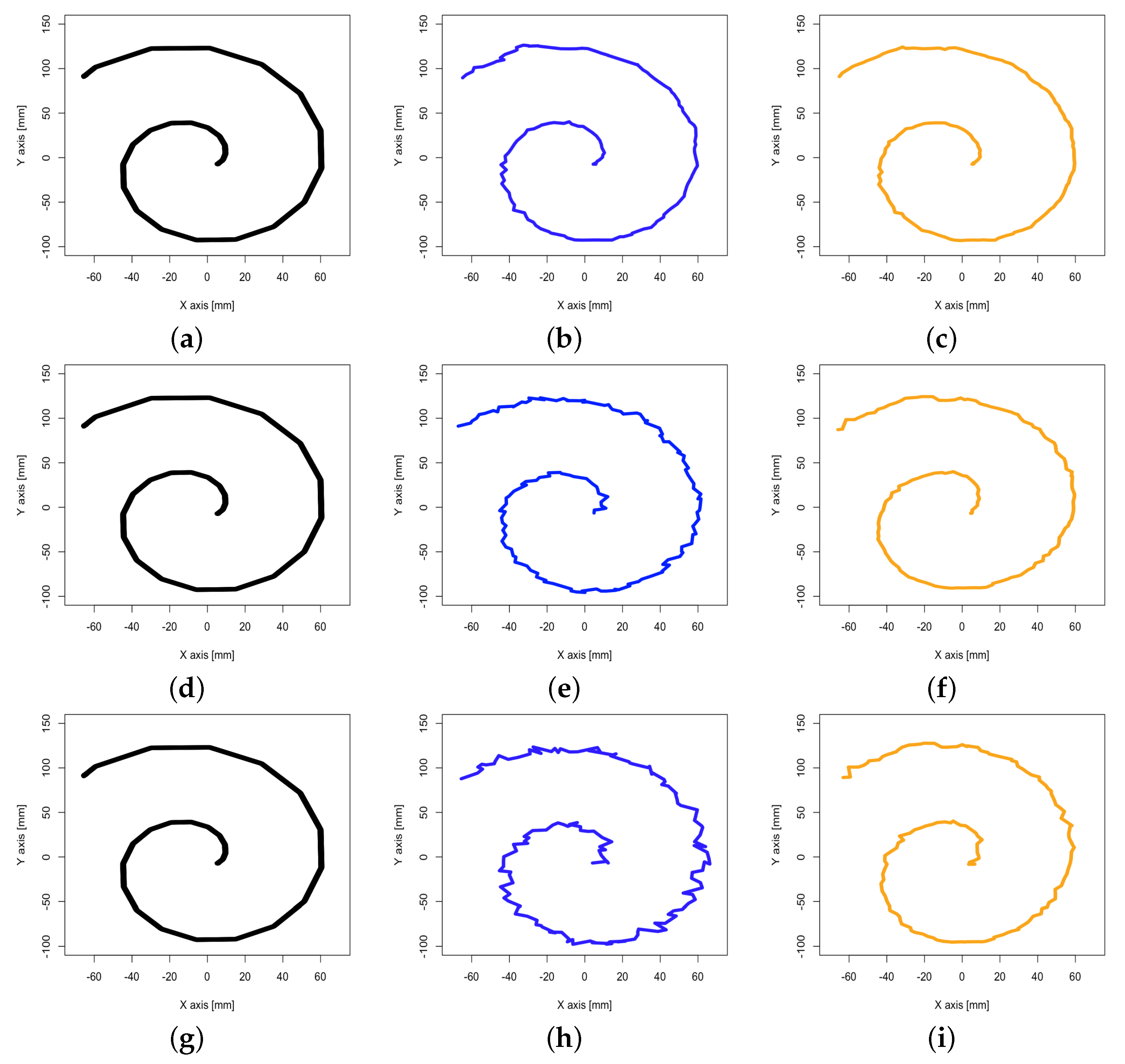
| RMSE | Axis | Two Base Stations mm (sd) | Four Base Stations mm (sd) |
|---|---|---|---|
| Movement direction | X | 0.393 (0.363) | 0.085 (0.083) |
| Y | 0.345 (0.347) | 0.199 (0.117) | |
| Z | 0.551 (0.499) | 0.158 (0.112) | |
| All | 0.429 (0.403) | 0.155 (0.104) | |
| Mean in all directions | X | 0.296 (0.455) | 0.167 (0.107) |
| Y | 0.458 (0.418) | 0.223 (0.096) | |
| Z | 0.386 (0.335) | 0.101 (0.074) | |
| All | 0.435 (0.217) | 0.171 (0.092) |
| RMSE | Axis | Two Base Stations ° (sd) | Four Base Stations ° (sd) |
|---|---|---|---|
| Movement direction | X | 0.827 (0.029) | 0.375a (0.297) a |
| Y | 0.474 (0.126) | 0.086 (0.066) | |
| Z | 0.125 (0.053) | 0.084 (0.076) | |
| All | 0.574 (0.069) | 0.227a (0.146) a | |
| Mean in all directions | X | 0.493 (0.065) | 0.234a (0.143) a |
| Y | 0.385 (0.160) | 0.222a (0.142) a | |
| Z | 0.503 (0.046) | 0.203a (0.131) a | |
| All | 0.460 (0.090) | 0.220a (0.139) a |
| RMSE | Axis | Two Base Stations | Four Base Stations | ||||
|---|---|---|---|---|---|---|---|
| Slow mm (sd) | Medium mm (sd) | Fast mm (sd) | Slow mm (sd) | Medium mm (sd) | Fast mm (sd) | ||
| Movement direction | X | 6.130 (5.872) | 11.320 (9.215) | 14.377 (15.217) | 0.316 (0.444) | 2.020 (1.998) | 5.537 (5.421) |
| Y | 0.899 (0.912) | 1.990 (2.146) | 4.727 (5.231) | 0.637 (0.513) | 1.994 (1.876) | 2.144 (1.965) | |
| Z | 1.165 (1.231) | 13.910 (12.731) | 15.432 (15.144) | 0.823 (0.781) | 2.508 (2.322) | 4.376 (4.451) | |
| All | 2.824 (2.672) | 8.664 (8.031) | 11.091 (11.864) | 0.574 (0.579) | 2.164 (2.065) | 4.237 (3.946) | |
| RMSE | Axis | Base Station Occlusion | |||
|---|---|---|---|---|---|
| Base Station 1 mm (sd) | Base Station 2 mm (sd) | Base Station 3 mm (sd) | Base Station 4 mm (sd) | ||
| Movement direction | X | 0.108 (0.102) | 0.095 (0.089) | 0.242 (0.232) | 0.142 (0.121) |
| Y | 0.636 (0.545) | 0.637 (0.589) | 1.318 b (0.914) b | 0.861 (0.774) | |
| Z | 1.663 a (1.487) a | 0.777 (0.654) | 0.930 (0.887) | 0.840 (0.762) | |
| All | 0.781 a (0.711) a | 0.531 (0.444) | 0.823 b (0.678) b | 0.583 (0.552) | |
| Mean in all directions | X | 0.605 (0.547) | 0.345 (0.421) | 0.638 (0.429) | 0.441 (0.532) |
| Y | 0.518 (0.465) | 0.699 (0.327) | 0.974 b (0.678) b | 0.689 (0.546) | |
| Z | 1.093 a (0.568) a | 0.789 (0.487) | 0.989 (0.478) | 0.661 (0.525) | |
| All | 0.738 a (0.699) a | 0.611 (0.528) | 0.867 b (0.528) b | 0.597 (0.534) | |
Disclaimer/Publisher’s Note: The statements, opinions and data contained in all publications are solely those of the individual author(s) and contributor(s) and not of MDPI and/or the editor(s). MDPI and/or the editor(s) disclaim responsibility for any injury to people or property resulting from any ideas, methods, instructions or products referred to in the content. |
© 2023 by the authors. Licensee MDPI, Basel, Switzerland. This article is an open access article distributed under the terms and conditions of the Creative Commons Attribution (CC BY) license (https://creativecommons.org/licenses/by/4.0/).
Share and Cite
Kuhlmann de Canaviri, L.; Meiszl, K.; Hussein, V.; Abbassi, P.; Mirraziroudsari, S.D.; Hake, L.; Potthast, T.; Ratert, F.; Schulten, T.; Silberbach, M.; et al. Static and Dynamic Accuracy and Occlusion Robustness of SteamVR Tracking 2.0 in Multi-Base Station Setups. Sensors 2023, 23, 725. https://doi.org/10.3390/s23020725
Kuhlmann de Canaviri L, Meiszl K, Hussein V, Abbassi P, Mirraziroudsari SD, Hake L, Potthast T, Ratert F, Schulten T, Silberbach M, et al. Static and Dynamic Accuracy and Occlusion Robustness of SteamVR Tracking 2.0 in Multi-Base Station Setups. Sensors. 2023; 23(2):725. https://doi.org/10.3390/s23020725
Chicago/Turabian StyleKuhlmann de Canaviri, Lara, Katharina Meiszl, Vana Hussein, Pegah Abbassi, Seyedeh Delaram Mirraziroudsari, Laurin Hake, Tobias Potthast, Fabian Ratert, Tessa Schulten, Marc Silberbach, and et al. 2023. "Static and Dynamic Accuracy and Occlusion Robustness of SteamVR Tracking 2.0 in Multi-Base Station Setups" Sensors 23, no. 2: 725. https://doi.org/10.3390/s23020725
APA StyleKuhlmann de Canaviri, L., Meiszl, K., Hussein, V., Abbassi, P., Mirraziroudsari, S. D., Hake, L., Potthast, T., Ratert, F., Schulten, T., Silberbach, M., Warnecke, Y., Wiswede, D., Schiprowski, W., Heß, D., Brüngel, R., & Friedrich, C. M. (2023). Static and Dynamic Accuracy and Occlusion Robustness of SteamVR Tracking 2.0 in Multi-Base Station Setups. Sensors, 23(2), 725. https://doi.org/10.3390/s23020725







